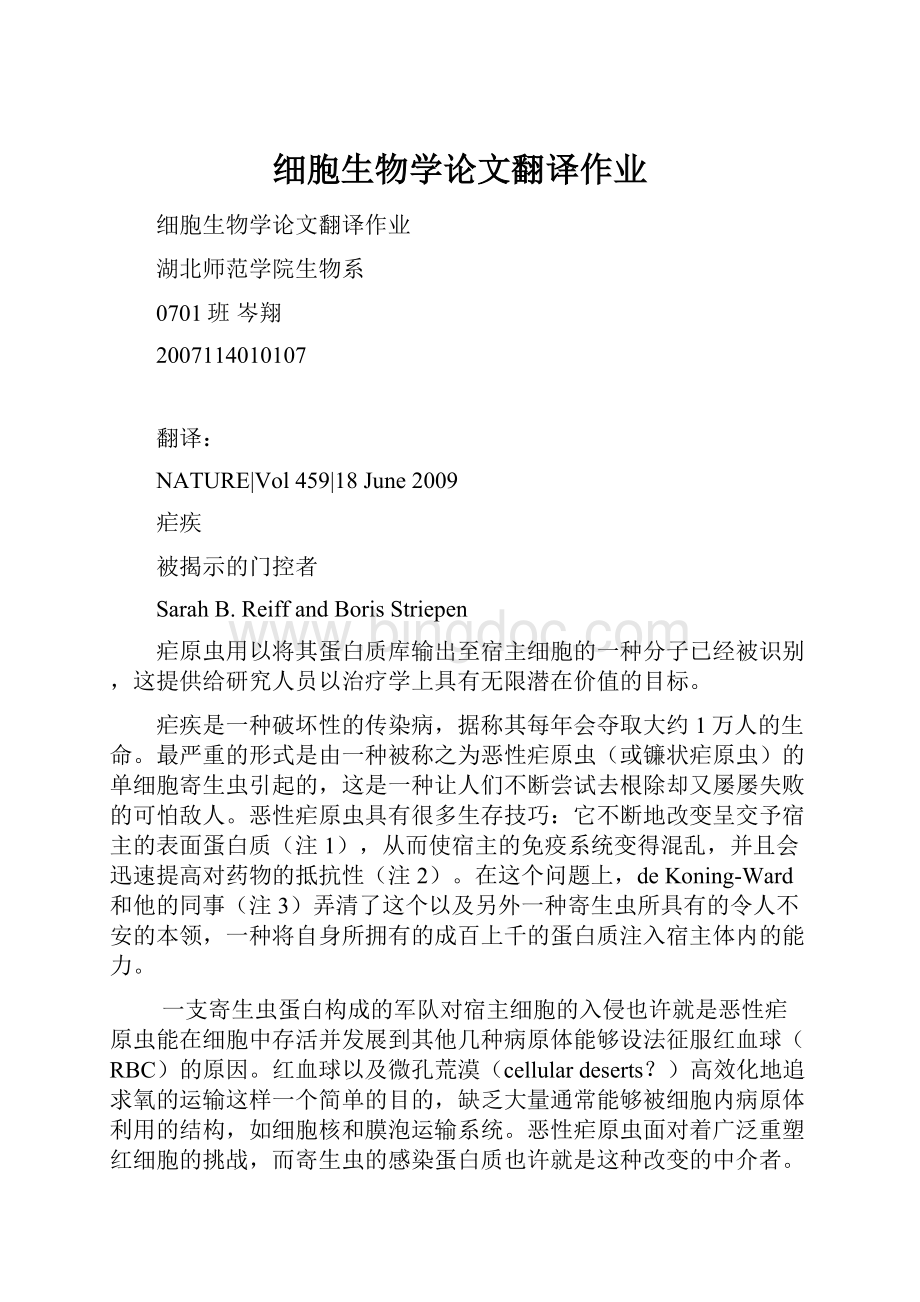细胞生物学论文翻译作业.docx
《细胞生物学论文翻译作业.docx》由会员分享,可在线阅读,更多相关《细胞生物学论文翻译作业.docx(11页珍藏版)》请在冰点文库上搜索。

细胞生物学论文翻译作业
细胞生物学论文翻译作业
湖北师范学院生物系
0701班岑翔
2007114010107
翻译:
NATURE|Vol459|18June2009
疟疾
被揭示的门控者
SarahB.ReiffandBorisStriepen
疟原虫用以将其蛋白质库输出至宿主细胞的一种分子已经被识别,这提供给研究人员以治疗学上具有无限潜在价值的目标。
疟疾是一种破坏性的传染病,据称其每年会夺取大约1万人的生命。
最严重的形式是由一种被称之为恶性疟原虫(或镰状疟原虫)的单细胞寄生虫引起的,这是一种让人们不断尝试去根除却又屡屡失败的可怕敌人。
恶性疟原虫具有很多生存技巧:
它不断地改变呈交予宿主的表面蛋白质(注1),从而使宿主的免疫系统变得混乱,并且会迅速提高对药物的抵抗性(注2)。
在这个问题上,deKoning-Ward和他的同事(注3)弄清了这个以及另外一种寄生虫所具有的令人不安的本领,一种将自身所拥有的成百上千的蛋白质注入宿主体内的能力。
一支寄生虫蛋白构成的军队对宿主细胞的入侵也许就是恶性疟原虫能在细胞中存活并发展到其他几种病原体能够设法征服红血球(RBC)的原因。
红血球以及微孔荒漠(cellulardeserts?
)高效化地追求氧的运输这样一个简单的目的,缺乏大量通常能够被细胞内病原体利用的结构,如细胞核和膜泡运输系统。
恶性疟原虫面对着广泛重塑红细胞的挑战,而寄生虫的感染蛋白质也许就是这种改变的中介者。
其中的一项改变就是在红血球表面像分子魔术贴一样的旋钮构造,这导致了被感染的细胞粘附在毛细血管内层(注4)。
通过藏身于循环系统外围的方式,被感染的细胞似乎在避免在脾脏中被消除。
宿主的结果非常悲惨--大量被感染的红血球在大脑和肾的毛细血管的积累会导致器官最终死亡。
恶性疟原虫用以将其蛋白质输出至红血球细胞质的机制曾被疟疾研究者狂热地追求。
了解这一过程能帮助发展阻止寄生虫生长或限制严重疾病的介入手段。
恶性疟原虫居住在红血球液胞内部并且需要在将蛋白质输出到目的地的过程中跨越几道生理性阻碍。
这些阻碍包括寄生虫膜,液胞膜,以及对于很多蛋白质来说还有红血球膜。
蛋白质由寄生虫运往液胞空间的这种典型分泌路线存在于所有真核细胞中(具有细胞核和膜结构细胞器的细胞)。
但是蛋白质如何穿过液胞膜仍然是个迷。
对于一种特殊的“输出地址标签”的鉴定(注5,6)(疟原虫属蛋白质基元序列的氨基末端导致了它们从液胞中输出)是一个重大进展并使得作者得出了他们当前的假设(注3)。
他们假定红血球液胞膜上有一个“门控者”
能读取输出标签并把蛋白质传递到红血球细胞质中,他们进一步假定那个“门控者”是由被他们称之为疟原虫属易位子输出蛋白(PTEX)的寄生虫蛋白质构成的复合体。
为了找到液胞膜运输蛋白存在的的证据,deKoning-Ward和他的同事(注3)总结出一个潜在的PTEX构成要素的所需特征清单:
必须是当前在血液阶段中的寄生虫,必须是对寄生虫在红血球中生长所必不可少的,被寄生虫所分泌,并且与液胞膜联系在一起。
使用这些标准和一系列的生物信息学、遗传学以及生物化学手段,他们将候选范围从数百种寄生虫蛋白减小到两种,分别叫做HSP101和PTEX150。
HSP101是一种属于AAA+级ATPases(ATP泵)超家族的酶,并且有能力将ATP提供给蛋白质传输作为动力能源。
PTEX150是一种新鉴定的能与HSP101相互作用的寄生虫蛋白,符合构成PTEX潜在结构的特征。
生物化学实验额外鉴别出三种近似的PTEX组分。
其中,EXP2非常有趣,由于它是一种积分膜蛋白,所以可以
停在PTEX复合体和液胞膜上并作为一种孔潜在发挥作用。
所以deKoning-Ward和他的同事(注3)似乎已经鉴定出PTEX允许其发挥“门控者”作用的所需组成结构。
但是PTEX真的运输蛋白质么?
坐着令人信服地展示了这受到货物蛋白的影响,重要的是,这仅仅在蛋白质携带出口地址标签时才成立,这也与之前假设的功能是相一致的。
PTEX假设不是唯一一个假设出来用于解释疟疾蛋白质输出的模型,另外一些人提出一种基于液胞运输小泡的萌芽的模型(注7),这些小泡被预测为在被感染的细胞中将转化为膜结构并被称之为毛雷尔氏小点。
也许这几套不同的尤其是在命运和物理性质上都各不相同的蛋白质需要不同的机器去找到它们的目标位置。
第三种潜在的模型在卵菌研究中被提出。
他们培养一种看起来像真菌的病原体,但实际在进化角度上与疟原虫关系紧密,而且他们同样把蛋白质输出到宿主细胞内。
有趣的是,这些蛋白质在卵菌与疟原虫属彼此的输出转运中相互分享、相互交换疟原虫属出口地址标签(注8,9)。
卵菌研究者有两个额外发现:
他们注意到地址标签同样在宿主蛋白质中被发现,而且这些运输标签的蛋白质还能在缺少病原体的情况下进入宿主细胞(注10,11)。
这可能表明,这些病原体颠覆了运输元素自然存在于宿主细胞膜的结论。
研究被认为是涉及到这些模型的不同版本的重要对象将提供关键性的见解。
比如,缺失基因编码PTEX复合物的成分将会溶解蛋白出口并提供关于PTEX结构的确切证据。
导致疟原虫突变的技术障碍也于近期被排除(注12),当前的论文(注3)提供了一个关于PTEX功能的强有力的机械模型,并且非常关键地识别了一系列将在未来被得以确认的优良的候选基因。
SarahB.ReiffandBorisStriepenareattheCenter
forTropicalandEmergingGlobalDiseases,and
theDepartmentofCellularBiology,Universityof
Georgia,Athens,Georgia30602,USA.
e-mail:
striepen@cb.uga.edu
1.Scherf,A.,Lopez-Rubio,J.J.&Riviere,L.Annu.Rev.
Microbiol.62,445–470(2008).
2.Baird,J.K.N.Engl.J.Med.352,1565–1577(2005).
3.deKoning-Ward,T.F.etal.Nature459,945–949(2009).
4.Crabb,B.S.etal.Cell89,287–296(1997).
5.Marti,M.etal.Science306,1930–1933(2004).
6.Hiller,N.L.etal.Science306,1934–1937(2004).
7.Bhattacharjee,S.etal.Blood111,2418–2426(2008).
8.Bhattacharjee,S.etal.PLoSPathog.2,e50(2006).
9.Grouffaud,S.etal.Microbiology154,3743–3751(2008).
10.Birch,P.R.etal.Curr.Opin.PlantBiol.11,373–379(2008).
11.Dou,D.etal.PlantCell20,1930–1947(2008).
12.Combe,A.etal.CellHostMicrobe5,386–396(2009).
原文:
MALARIA
Thegatekeeperrevealed
SarahB.ReiffandBorisStriepen
Amolecularmachineusedbythemalariaparasitetoexportitsproteinarmouryintothehostcellhasatlastbeenidentified,providingresearcherswithapotentiallyinvaluabletherapeutictarget.
Malariaisadevastatinginfectiousdisease
thatclaimsaroundonemillionliveseachyear.
Themostsevereformiscausedbyaunicellular
parasitecalledPlasmodiumfalciparum
—aformidablefoethathasrepeatedlyfrustrated
attemptstoeradicateit.P.falciparum
hasmanysurvivaltricks:
itconstantlyvaries
thesurfaceproteinspresentedtothehost1,
therebyconfoundingthehostimmunesystem,
anditrapidlydevelopsresistancetodrugs2.
Inthisissue(page945),deKoning-Wardand
colleagues3gettothebottomofyetanother
oftheparasite’sunsettlingtalents,the
abilitytoinjecthundredsofitsown
proteinsintothehostcell.
Theinvasionofthehostcellbyan
armyofparasiteproteinsisprobably
onereasonwhyP.falciparum
cansurviveanddevelopinacellthat
fewotherpathogenshavemanaged
toconquer,theredbloodcell(RBC).
Streamlinedforasinglepurpose—the
transportofoxygen—RBCsarecellular
deserts,lackingmanyoftheamenities
usuallyenjoyedbyintracellularpathogens,
suchasanucleusandavesiculartransport
system.P.falciparummastersthischallenge
byextensiveremodellingoftheRBC,andthe
parasite’sinjectedproteinsareprobablythe
agentsofthesechanges.Onesuchchangeis
theformationofknobsontheRBCsurfacethat
behavelikemolecularVelcro,resultinginadhesion
ofinfectedcellstotheliningofcapillary
bloodvessels4.Byhidingoutintheperiphery
ofthecirculatorysysteminthisway,infected
cellsseemtoavoideliminationinthespleen.
Theconsequencesforthehostaredire—the
massiveaccumulationofinfectedRBCsinthe
capillarybedsofthebrainandkidneycanlead
toorganfailureandultimatelydeath.
ThemechanismusedbyP.falciparumto
exportproteinstotheRBCcytoplasmhas
beenhotlypursuedbymalariaresearchers.
Understandingthisprocesscouldaidthe
developmentofinterventionsthatblockthe
parasite’sgrowthorlimittheseverityofthe
disease.IntheRBC,P.falciparumresides
insideavacuole,andexportedproteinsmust
overcomeseveralphysicalbarriersenrouteto
theirdestinations.Thesebarriersincludethe
parasitemembrane,thevacuolemembrane
and,forsomeproteins,theRBCmembrane.
Proteinsexportedfromtheparasiteintothe
vacuolarspacefollowthetypicalsecretion
pathwaythatexistsinalleukaryoticcells
(cellswithanucleusandmembrane-bound
organelles).Buthowtheseproteinscross
thevacuolemembranehasremainedamystery.
Theidentification5,6ofaspecific‘export
addresstag’—asequencemotifattheamino
terminusofPlasmodiumproteinsthatresultsin
theirexportoutofthevacuole—wasamajor
advance,andledtheauthorstotheircurrent
hypothesis3.Theyproposethatthereisa‘gatekeeper’
inthevacuolemembranethatreads
theexporttaganddeliversproteinsfromthe
vacuoleintotheRBCcytoplasm(Fig.1).They
furtherassumethatthegatekeeperismade
upofacomplexofparasiteproteinsthatthey
callthePlasmodiumtransloconofexported
proteins(PTEX).
Tofindevidenceofavacuolarmembrane
proteintransporter,deKoning-Wardand
colleagues3assembledalistofrequiredcharacteristics
ofpotentialPTEXcomponents:
they
shouldbepresentintheblood-stageparasite,
beessentialforparasitegrowthinRBCs,be
secretedfromtheparasite,andassociatewith
thevacuolemembrane.Usingthesecriteria
andabatteryofbioinformatics,geneticand
biochemicalapproaches,theynarrowedthe
fieldfromhundredsofcandidatestotwoparasite
proteins,calledHSP101andPTEX150.
HSP101isanenzymebelongingtotheAAA+
superfamilyofATPases,andwouldbeableto
powerproteinexportusingATPasanenergy
source.PTEX150isanewlyidentifiedparasite
proteinthatinteractswithHSP101,afeature
consistentwithitsbeingapotentialcomponent
ofthePTEX.Biochemicalexperiments
identifiedanadditionalthreelikelyPTEX
components.Amongthese,EXP2isparticularly
interesting,asitisanintegralmembrane
proteinandcouldthereforeanchorthePTEX
complextothevacuolemembraneand
potentiallyfunctionasapore.
SodeKoning-Wardandcolleagues3seem
tohaveidentifiedthenecessarycomponents
forthePTEXthatwouldallowittofunction
asagatekeeper.ButdoesthePTEXactually
exportproteins?
Theauthorsshowconvincingly
thatitinteractswithcargoproteinsand,
importantly,doessoonlyiftheproteincarries
theexportaddresstag,whichisconsistentwith
itsproposedfunction.
ThePTEXhypothesisisnottheonlymodel
proposedtoexplainmalariaproteinexport.
Anothersuggestedmodel7isbasedonthe
buddingoftransportvesiclesfromthevacuole.
Thesevesiclesarethenpredictedtotransform
intomembranousstructuresintheinfected
cellknownasMaurer’sclefts.It’spossiblethat
differentsetsofproteins,especiallythose
withdifferentdestiniesorphysicalproperties,
requiredifferentmachinerytoreachtheir
targetlocations.
Athirdpotentialmodelarisesfromstudies
onoomycetes.Theseplantpathogenslooklike
fungi,butareactuallyevolutionarilyrelated
tomalariaparasitesandalsoexportproteins
intothecellsoftheirhosts.Intriguingly,these
proteinssharethePlasmodiumexportaddress
tag,andswappingtagsbetweenoomycetes
andPlasmodiumresultsinexportinboth
cases8,9.Oomyceteresearchershavemadetwo
additionalobservations:
theynotedthatthe
addresstagisalsofoundonhostproteins,and
thatproteinscarryingthetagcangainentryto
hostcellsintheabsenceofthepathogen10,11.
Thismightsuggestthatthepathogensaresubverting
transportelementsnaturallypresentin
hostmembranes.
Studyingmutatedversionsofanyofthe
centralplayersthoughttobeinvolvedinthese
modelswouldprovidecrucialinsights.For
instance,deletionofthegenesencodingthe
componentsofthePTEXcomplexshould
ablateproteinexportandprovideconclusive
proofofthePTEXmechanism.Some
ofthetechnicalobstaclestogeneratingsuch
mutantsinthemalariaparasitehaverecently
beenremoved12.Thecurrentpaper3provides
astrongmechanisticmodelofPTEXfunction
and,crucially,identifiesalistofexcellent
candidategenestobevalidatedinthefuture.■
SarahB.ReiffandBorisStriepenareattheCenter
forTropicalandEmergingGlobalDiseases,and
theDepartmentofCellularBiology,